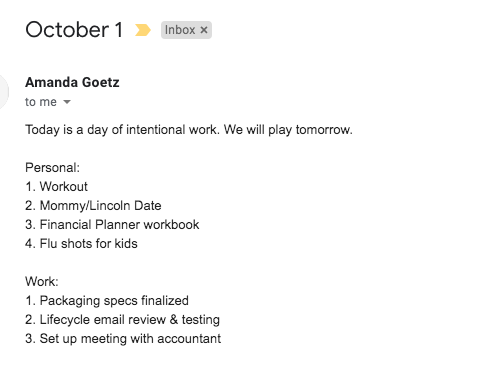
Good morning!
Welcome to Action Items! It’s a series of articles where we’ll condense and summarize each of our interviews into actionable bullet points—only for paid subscribers.
First up this week: Amanda Goetz. She’s the head of brand marketing at the Knot, a mom of three, and startup founder—she’s got a ton of actionable takeaways for us to cover.
Today’s Action Item is 774 words or 3.5 minutes of actionable learnings.
Let’s dive in!
☀️ Set intentions and goals
- Amanda gets up at 6am every day and sends herself an email outlining an intention, and her goals for the day
- Setting goals and intentions helps her set expectations, and zero in on what’s important
Dan's Take
- This routine works because it makes our expectations explicit, so that they can be intentionally lowered when necessary.
- Our default is to imagine every day should be a 12-hour productivity marathon. The reality is releasing yourself from your expectations every so often can be just as important to your productivity as any other hack
🏃♀️ Play offense with a 90-minute work sprint
Amanda gets the most done in the morning so she schedules a 90-minute focused work sprint during that time to power through her most important tasks.
Go Deeper
In order to create space for focus, you need to signal that you shouldn’t be disturbed.
- If you’re working at home with kids, consider using a Concentration Crown during your work sprints. It’s a special hat that you put on when you’re working so that your kids (and your partner) know that you need to focus.
👩👧 + 💻 Bopping around time
Amanda spends her afternoon doing what she calls “bopping around time,” where the boundaries between work and family are fluid.
For example, she’ll allow her kids to sit on her lap during Zoom meetings, and her colleagues know to expect it.
Dan's Take
- Typical productivity advice is to create explicit boundaries between different areas of your life—but that doesn’t work for every brain or lifestyle.
- If hermetically sealed boundaries aren’t right for you, try blending—the key is to communicate clearly with people in your life about what they should expect from you.
✅ Power hour
Amanda keeps a running list of annoying tasks like paying bills and scheduling appointments in the Notes app on her phone. Every other week she schedules an hour to power through as many of them as possible.
Big takeaway: It’s not about completion. “The list never ends — it just keeps growing, and I keep tackling it!” Amanda says.
⏰ The 10-10-10 test
When she’s making a hard decision Amanda uses the 10-10-10 test.
📕 Read: Suzy Welch on how she developed the 10-10-10 rule.
📣 KEY TAKEAWAY
I don’t believe in balancing the different parts of my life — I don’t think it’s possible to balance everything. Even before the pandemic, I didn’t believe in a separation between ‘work life’ and ‘personal life’ — I mean, they’re both your life, and they happen together!
QUESTIONS FOR REFLECTION:
Balance is a loaded word. It’s not the first time we’ve seen parents saying that they don’t believe in it. Here’s a few questions to ask yourself:
- What does balance mean to you?
- What can you get rid of in your life?
- Where you allocating too much time? Where are you not allocating enough?
- Where are your expectations too high?
For the full story on Amanda’s work and how she developed these systems over time, check the full interview with her here.
Did you like this summary? Have ideas for how I can make it better? Leave feedback in the comments or the form below!
This article was co-written by Dan Shipper and Annaliese Griffin.
The Only Subscription
You Need to
Stay at the
Edge of AI
The essential toolkit for those shaping the future
"This might be the best value you
can get from an AI subscription."
- Jay S.
Join 100,000+ leaders, builders, and innovators

Email address
Already have an account? Sign in
What is included in a subscription?
Daily insights from AI pioneers + early access to powerful AI tools











Comments
Don't have an account? Sign up!